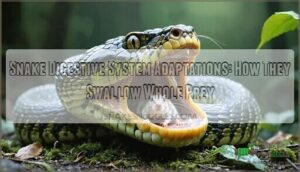This site is supported by our readers. We may earn a commission, at no cost to you, if you purchase through links.

Snake digestive system adaptations let these incredible hunters gulp down prey much larger than their heads. Their jaws unhinge like a master locksmith’s tool, stretching wide enough to accommodate meals that’d make your jaw drop.
Backward-curved teeth act like tiny fishhooks, ensuring dinner doesn’t escape once the feast begins. Powerful stomach acids work overtime, breaking down bones, fur, and scales with industrial strength.
Meanwhile, their stretchy throat and body expand like a living accordion to accommodate bulky meals. But the real magic happens behind the scenes with specialized features you’ve never imagined, including the ability to break down meals with powerful stomach acids, and the stretchy throat that allows them to swallow large prey, making their digestive system a true marvel of nature’s most impressive eating tricks.
Table Of Contents
- Key Takeaways
- Adaptations of The Digestive System
- Modified Skull Features and Body Structures
- Frequently Asked Questions (FAQs)
- What are the adaptations of the digestive system?
- What are 5 adaptations of a snake?
- How does a snake’s digestive system work?
- What adaptations help snakes find food?
- What is unique about snakes digestive system?
- What are some adaptations of the digestive system?
- What are the adaptations of a snake eating?
- What are 3 adaptations of a snake?
- How long can digestion take in snakes?
- What is the role of stomach acid in digestion?
- Conclusion
Key Takeaways
- You’ll discover that snakes can unhinge their flexible jaws and stretch their skulls to swallow prey much larger than their head size through remarkable bone and ligament adaptations.
- You’ll find that backward-curved teeth act like natural fishhooks, preventing prey from escaping once it’s caught, while specialized saliva glands produce lubricating enzymes that ease swallowing.
- You’ll learn that snakes possess forked tongues that work as sophisticated chemical sensors, collecting scent particles and transferring them to their vomeronasal organ for precise prey detection.
- You’ll see that powerful stomach acids work like industrial-strength chemicals, completely dissolving bones, fur, and scales over periods ranging from days to weeks depending on meal size.
Adaptations of The Digestive System
You’ve probably wondered how snakes manage to swallow prey much larger than their head without choking.
Their digestive system features remarkable adaptations that make this seemingly impossible feat routine, from flexible jaws that unhinge to specialized saliva that eases the journey down their throat.
Modified Teeth and Jaws for Large Prey Consumption
When you consider how snakes consume prey much larger than their heads, you’ll discover their jaw mechanics work like biological hinges.
Nature’s biological hinges unlock the impossible—swallowing prey twice your head size with mechanical precision.
Their flexible mandibles can dislocate and move independently, while backward-pointing teeth prevent prey from escaping.
Dynamic skull connections through elastic skull ligaments enable remarkable jaw mobility and skull flexibility.
You can even purchase snake jaw models for study.
- Watch a snake’s jaw "walk" around massive prey through coordinated bone movements
- Marvel at teeth that curve inward like nature’s own fish hooks
- Witness skulls that stretch beyond what seems physically possible
Saliva-Producing Glands With Specific Roles in Swallowing Prey Whole
You’ll find snakes pack eight different oral glands that work like nature’s lubricant factory.
Nature’s most sophisticated oral glands transform massive prey into manageable meals through strategic lubrication.
These glandular adaptations produce saliva loaded with saliva enzymes and mucopolysaccharides, creating a slick lubricant that coats prey.
This saliva lubrication transforms swallowing mechanics into efficient swallowing, while venom pre-digestion from modified salivary glands jumpstarts breakdown before prey reaches the stomach.
The snake’s ability to swallow large prey is aided by its kinetic skull structure.
Snake Tongue Sensing Role
Your snake’s forked tongue acts like nature’s most sophisticated chemical sensor.
When it flicks out, the tongue collects chemical signals from the air and ground, then transfers them to the vomeronasal organ in the mouth.
This tongue chemoreception system helps snakes sniff out prey with incredible precision, making prey detection and environmental sensing remarkably efficient before they even strike.
This process allows them to create a 3D scent map for directional tracking.
Modified Skull Features and Body Structures
You’ll discover that a snake’s skull isn’t just one solid piece—it’s actually made up of multiple bone segments connected by stretchy ligaments that work like biological hinges.
This remarkable design lets snakes unhinge their jaws and expand their skull to accommodate prey that’s much larger than their head, basically turning their entire skull into a flexible swallowing machine that is capable of consuming large prey.
Jaw Mobility Adaptations
You’ll witness jaw mobility adaptations that work like a mechanical marvel.
Mandible flexibility and skull kinesis allow snakes to unhinge their flexible jaws, creating incredible gape width. Ligament elasticity connects jaw bones, enabling independent movement during jaw walking—a process where each side grips prey alternately.
This remarkable adaptation is central to snake feeding strategies.
- Independent mandible movement – Each jaw side operates separately during prey consumption
- Elastic ligament connections – Stretchy tissues allow extreme jaw realignment and flexibility
- Skull kinesis mechanisms – Multiple skull joints enable dramatic expansion for large prey size
- Coordinated jaw walking – Alternating grip-and-release motion pulls prey inward efficiently
Tooth Structure Function
Backward-pointing teeth create a one-way trap for escaping prey.
You’ll find four dentition types among snakes: aglyphous (no fangs), opisthoglyphous (rear-fanged), proteroglyphous (fixed front fangs), and solenoglyphous (hinged fangs).
Tooth morphology varies by diet—sharp, curved teeth grip soft prey while blunt teeth handle tough shells.
Tooth replacement happens continuously throughout life, preventing wear issues.
Venom delivery through hollow or grooved fangs maximizes efficiency.
These evolutionary trends reflect dietary specialization across species.
Snakes typically have six rows of teeth to effectively grasp their prey.
Skull Flexibility Mechanisms
You’ll discover how skull kinetics enable snakes’ incredible feeding abilities.
Loose skull connections and ligament elasticity allow jaw decoupling, creating flexible jaws that expand dramatically.
Multiple cranial joints work together, letting each jaw section move independently.
This bone remodeling system transforms rigid structures into adaptable feeding machines, making jaw mobility adaptations essential for swallowing oversized prey.
Frequently Asked Questions (FAQs)
What are the adaptations of the digestive system?
Like a biological Swiss Army knife, your digestive system boasts incredible adaptations.
You’ll find flexible jaws that unhinge, stretchy esophagus, powerful stomach acids, and metabolic surge capabilities for processing whole prey efficiently, which allows for a powerful stomach.
What are 5 adaptations of a snake?
Snakes have flexible jaws that unhinge to swallow massive prey, backward-pointing teeth that prevent escape, stretchy esophagus with internal folds, powerful stomach acids, and metabolic surge capabilities during digestion.
How does a snake’s digestive system work?
When you watch a snake swallow prey, you’re seeing an incredible digestive machine at work.
Their flexible jaws unhinge, stretchy esophagus accommodates large meals, and powerful stomach acids break everything down over days or weeks, which is a digestive process.
What adaptations help snakes find food?
Nature’s sleuths don’t rely on luck when hunting their next meal.
You’ll find snakes equipped with forked tongues that sample chemical trails, heat-sensing pits detecting warm-blooded prey, and specialized scales sensing ground vibrations from approaching animals.
They utilize these features to efficiently locate their prey.
What is unique about snakes digestive system?
You’ll find snakes can unhinge their jaws and stretch their throats to swallow prey much larger than their head.
Their flexible skull joints and backward-pointing teeth create this remarkable feeding ability.
What are some adaptations of the digestive system?
Flexible jaws with stretchy ligaments let you swallow prey whole, while specialized saliva lubricates meals. Your stomach produces powerful acids, and organs temporarily enlarge during digestion for maximum efficiency.
What are the adaptations of a snake eating?
How do snakes discover the secret to swallowing prey larger than their heads?
You’ll see flexible jaws with stretchy ligaments that "walk" independently around prey,
backward-pointing teeth preventing escape, and enzyme-rich saliva lubricating massive meals for efficient whole-body digestion.
The process involves enzyme-rich saliva for efficient digestion, highlighting the unique adaptations of snakes for consuming large prey.
What are 3 adaptations of a snake?
You’ll discover three remarkable adaptations that make snakes incredible predators.
Their flexible jaws unhinge to swallow prey much larger than their heads, powerful stomach acid dissolves bones completely, and specialized heat-sensing organs detect warm-blooded prey in darkness.
How long can digestion take in snakes?
You’ll find that snake digestion takes anywhere from several days to several weeks, depending on your snake’s meal size and environmental temperature conditions.
What is the role of stomach acid in digestion?
Imagine your stomach as a chemical warfare factory – that’s exactly what happens inside you!
Your stomach acid creates a corrosive environment with hydrochloric acid that breaks down proteins into smaller pieces for absorption.
Conclusion
Like a sophisticated biological machine fine-tuned over millions of years, snakes demonstrate nature’s engineering prowess through their remarkable feeding abilities.
You’ve discovered how snake digestive system adaptations work together seamlessly—from flexible jaws and backward-angled teeth to powerful acids and expandable bodies.
These incredible hunters can tackle prey several times their head size thanks to these perfectly coordinated systems.
Understanding these adaptations helps you appreciate how evolution creates such efficient predators in the natural world, showcasing nature’s engineering prowess.
- https://thehsi.org/2015/05/06/biting-off-more-than-they-can-chew-how-snakes-swallow-large-prey/
- https://www.scienceabc.com/nature/animals/how-do-snakes-digest-their-food-without-chewing-it-first.html
- https://campus.murraystate.edu/academic/faculty/tderting/cva_atlases/stephsnake/snakepage3.htm
- https://pubmed.ncbi.nlm.nih.gov/10934002/
- https://timesofindia.indiatimes.com/etimes/trending/how-a-snakes-digestive-system-is-different-from-humans/articleshow/122528067.cms












